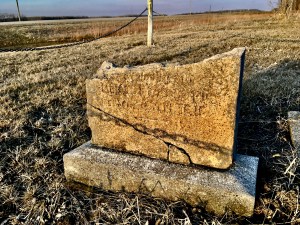
To my eyes, some historic sites in the East Reserve (R.M. of Hanover) are breathtakingly beautiful, such as Rosenfeld, with its tangled cemetery on a hill guarded by a tall pine.
However, most sites are undeniably stark, particularly when visited before the trees unfurl their leaves. This is when my dreamy imagination kicks in. (I suspect such a thing may be helpful in order to appreciate historic sites.)

Sometime this spring, prior to the pandemic, I convinced Andrew to head out to find Weidenfeld after work. The ground was rather saturated with water and our shoes became soggy.

There were no leaves yet, not much snow, waning light, and everything was kind of bare and depressing.
Really, a very fitting way to find a diminutive cemetery.

We raced along the 403, and I once again could not find it.
“It’s not here!” I announced to Andrew in frustration.
“Found it!” he replied, and parked at the Community Christian Fellowship Church.
Goodness. I didn’t even know this church existed. There are so many churches around here.
I know nothing of the history of this church (they don’t have a web presence) but I imagine its roots may lie in Weidenfeld. Because at the far corner of their expansive lawn, you’ll find this this cairn and the remains of two headstones in a chained-off, well-maintained little patch of land.

The Historical Atlas of the East Reserve led me here. In reading this book, I learned that this short-lived village was established outside the East Reserve by Harders and Doerksens returning from Paraguay in 1928. It boasted a cheese factory, a store, Lister school, and, naturally, a church. (Probably the same one on this site, though at the time they were likely meeting in a different building under a different name… maybe Chortitzer?)
The Atlas says that this area was referred to as the “Chaco” by the Steinbach Post. I’m thinking that this was likely because its settlers were returning from the Paraguayan Chaco at the time.
The absence of Doerksens on this cairn makes me think there is a Doerksen cemetery somewhere nearby… perhaps as of yet undiscovered. Or perhaps decimated. It’s a mystery.
Today, this is all that remains of Weidenfeld.





Personally, I love the stark beauty of this site. It’s a tad harsh, and even a tad weird. I’m grateful to the Atlas for pointing out these sites to explore and imagine about as the sun sets.


